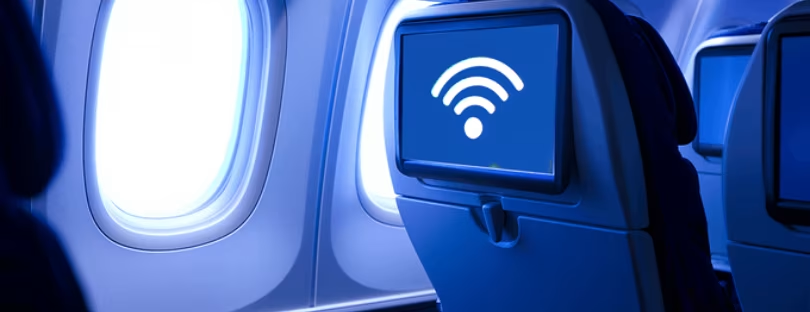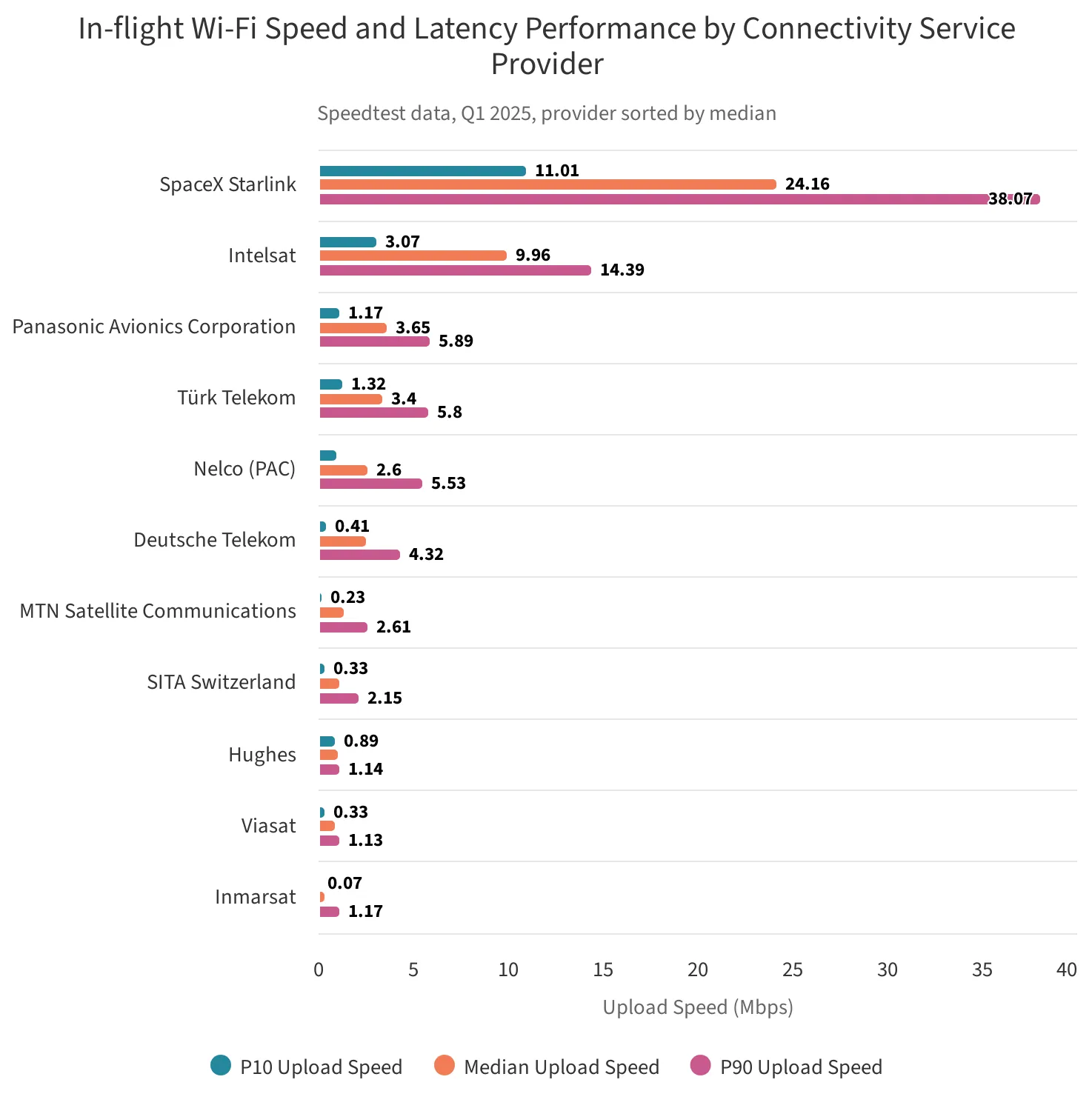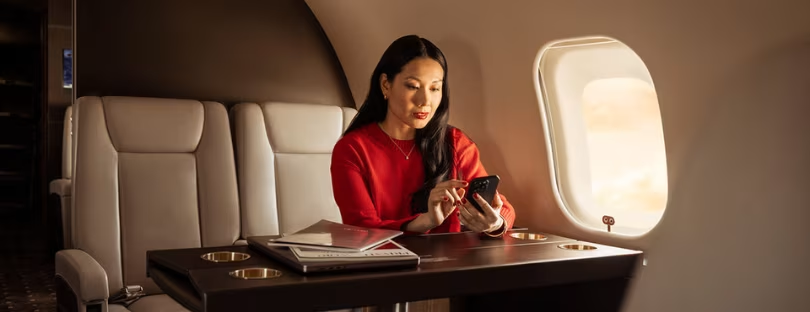
In-Flight Wi-Fi Leaders 2025: Speed Rankings by Airline and Provider
In 2025, in-flight Wi-Fi speed has emerged as a key battleground in the airline industry, with carriers and connectivity providers racing to deliver faster, more reliable service. As passenger expectations rise, onboard internet is no longer a perk—it’s a competitive differentiator and a growing source of brand value and revenue.
Today, Wi-Fi on planes is no longer a novelty but an expectation, much like hotel internet service. Reflecting this, the American Customer Satisfaction Index now includes “Quality of in-flight Wi-Fi” in its airline benchmarks. However, in-flight Wi-Fi ranked dead last among 21 categories, falling below baggage handling, seat comfort, and even airline food. This underscores the urgent need for airlines to improve the onboard connectivity experience.
What Do Passengers Really Expect at 35,000 Feet?
For today’s travelers, in-flight Wi-Fi is no longer a luxury—it’s a necessity. Whether it’s streaming Netflix, joining Zoom meetings, using WhatsApp, or posting in real-time on social media, passengers expect seamless, high-speed connectivity that mirrors their on-ground experience. According to a 2024 survey by Inmarsat, over 82% of global flyers said in-flight internet availability influences their choice of airline, and 67% are willing to switch carriers for better Wi-Fi.
Yet, very few airlines consistently meet these expectations. Only a handful—like Hawaiian Airlines and Qatar Airways—deliver speeds fast enough to comfortably stream video or support real-time collaboration tools. For many others, especially those still relying on GEO satellites or ground-to-air networks, connections often lag, buffer, or fail entirely during peak hours.
Social media sentiment reflects this frustration. Passengers frequently call out poor Wi-Fi experiences, citing it as a top in-flight disappointment—right behind delays and cramped seats. While benchmarks like the American Customer Satisfaction Index have started tracking Wi-Fi quality, independent traveler reviews and forums reveal a growing gap between promise and performance. As digital expectations rise, airlines that fail to upgrade connectivity risk losing tech-savvy, high-value customers to more forward-looking competitors.
Examining Wi-Fi Performance by Airline
Speedtest data for Q1 2025 reveals dramatic variations in in-flight Wi-Fi performance across airlines. Hawaiian Airlines and Qatar Airways stand out at the top, with significantly higher median download speeds and lower latency compared to competitors. Hawaiian Airlines delivers median download speeds exceeding 160 Mbps at the 50th percentile, while Qatar Airways also posts impressive results, both relying on SpaceX Starlink’s low-Earth orbit (LEO) satellite constellation.
Other airlines, such as Spirit Airlines, Air Canada, Delta Airlines, Breeze Airlines, American Airlines, and Aeromexico, also offer respectable connectivity. These carriers maintain 10th percentile download speeds above 10 Mbps, which ensures basic browsing and email remain usable for nearly all passengers. However, higher latency and lower upload speeds often limit real-time services such as video calling or gaming, which may even be welcomed by fellow passengers seeking a quieter cabin environment.
At the lower end of the rankings, airlines like Lufthansa are hindered by outdated connectivity infrastructure. Lufthansa’s service is often limited by the Deutsche Telekom LTE ground-to-air network, which results in a much slower and less consistent internet experience. Similarly, Japan Airlines, Turkish Airlines, and Cathay Pacific—despite their premium reputations—also appear at the lower end of Speedtest rankings, suggesting that parts of their fleets still use older, poorer-performing connectivity options.
The Role of Connectivity Service Providers
Connectivity providers play a crucial role in determining the quality of in-flight Wi-Fi. Airlines often contract multiple providers, and the technology used varies by aircraft model and route. SpaceX Starlink is the clear standout among providers, thanks to its dense LEO constellation that delivers median download speeds around 152 Mbps, median upload speeds over 24 Mbps, and exceptionally low latency near 44 milliseconds.
Other providers, like Hughes and Intelsat, offer strong multi-orbit solutions that combine GEO and LEO satellite capacity. Hughes delivers median download speeds above 84 Mbps, while Intelsat reaches over 61 Mbps. Both providers balance GEO coverage with LEO performance to improve speed and reliability. Viasat, a GEO-only provider, also performs well considering its technology, delivering median download speeds over 50 Mbps despite inherent latency challenges.
By contrast, providers such as Deutsche Telekom, which rely on a ground-based LTE network across Europe combined with GEO satellite, face significant limitations. Median download speeds barely exceed 4 Mbps, making the service barely usable for anything beyond basic messaging or email. This difference highlights how technological choices and satellite partnerships impact passengers’ experiences.
Partnerships and Coverage Strategies
Airlines must choose among a complex landscape of connectivity providers, each offering different advantages. For instance, Hawaiian Airlines and Qatar Airways have rapidly adopted Starlink to capitalize on its superior speed and latency. Other airlines diversify by working with multiple providers: American Airlines partners with Viasat and Intelsat, while Delta collaborates with Viasat and Hughes.
Connectivity service providers also differ in their business models. Some, like Panasonic Avionics Corporation, act as integrators rather than owning satellite constellations themselves. They partner with various satellite operators to offer hybrid solutions combining GEO and LEO networks. Panasonic’s approach allows airlines to mix and match capacity depending on routes and fleet configurations, offering flexible coverage but requiring careful integration and maintenance planning.
Meanwhile, providers like MTN Satellite Communications focus on niche markets including maritime and remote land-based services, while also offering in-flight connectivity. Similarly, Nelco in India partners with Intelsat to provide GEO-based connectivity over Indian airspace, illustrating the regional complexity of the industry.
Technology Advancements and Competitive Pressure
The shift from GEO to LEO technology is transforming expectations around in-flight Wi-Fi. While GEO satellites offer broad coverage, they struggle with latency, often exceeding 600 milliseconds. LEO networks like Starlink, by orbiting much closer to Earth, reduce latency to levels comparable with terrestrial broadband, making real-time applications far more viable on board aircraft.
Recognizing this advantage, airlines are investing heavily in upgrades. United Airlines, for example, is transitioning its entire fleet to Starlink service, promising free high-speed access for all MileagePlus members. SAS is also rolling out Starlink to offer free “gate-to-gate” Wi-Fi across its fleet by year’s end. These investments are not merely about passenger convenience but also about creating stickier customer loyalty and enhancing brand value in an increasingly competitive aviation market.
Other improvements come from onboard technology. Panasonic Avionics is pioneering the use of Wi-Fi 6E on aircraft, expanding bandwidth and reducing interference for passengers. Wi-Fi 6E supports the 6 GHz frequency band, which has more channels and faces less congestion than traditional 2.4 and 5 GHz bands, translating to faster, more reliable connections in crowded cabin environments.
What’s Next for In-Flight Wi-Fi
The battle for better in-flight internet is just getting started. SpaceX’s Starlink is rapidly scaling its low-Earth orbit (LEO) satellite network, setting a new benchmark for speed and latency. Meanwhile, Amazon’s Project Kuiper and AST SpaceMobile are preparing to enter the skies, offering fresh competition and promising to disrupt the status quo with broader coverage and potentially lower costs. Their arrival is expected to spark a wave of innovation—and pressure existing providers to improve performance or risk falling behind.
But satellites are only part of the equation. To fully unlock the potential of next-gen connectivity, airlines must also invest in modern onboard hardware and supporting ground infrastructure. Outdated antennas, limited onboard networks, and regulatory hurdles on certain international routes still hinder performance. Installation costs and fleet-wide upgrades remain significant, but avoiding them risks customer dissatisfaction and competitive irrelevance.
In 2025, in-flight Wi-Fi is no longer a perk—it’s a baseline expectation. Passengers want reliable, high-speed internet that allows them to stream, work, and stay connected throughout the flight. For airlines, delivering on that promise isn’t just about customer satisfaction—it’s about brand value, loyalty, and future growth. The winners in this space will be those that treat connectivity not as an afterthought, but as a core pillar of their passenger experience strategy.













